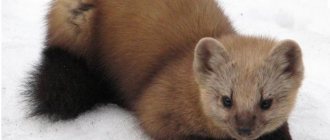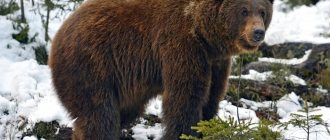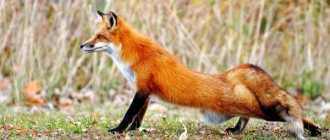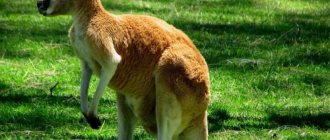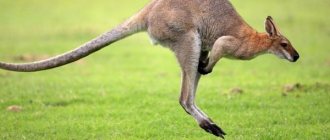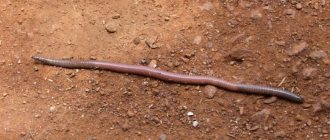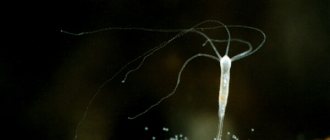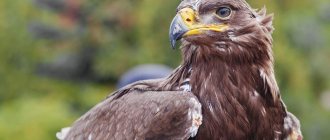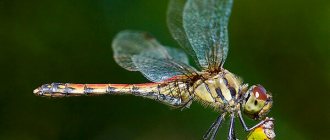The sable is a small but very agile predator from the mustelidae family. Representatives of the species prefer to settle in mixed forests consisting of conifers and deciduous trees with dense undergrowth. Populations are found in both flat and mountain areas.
Sables lead a sedentary life and pair up only for the breeding season. They rarely leave their area, but can migrate after food or when danger arises.
general characteristics
The size of a mature individual is from 40 to 60 cm, the tail is from 15 to 25 cm. Weight can reach 2 kg. Sexual dimorphism is weak, the external genitalia are hidden by fluffy fur. Usually females are slightly smaller than males, but only experts can visually determine the sex of an animal in its natural environment.
In appearance, sables strongly resemble their closest relatives, pine martens. But the sable has a larger head and a slightly pointed muzzle. In addition, sable fur is much more delicate than marten fur.
Sables have a slightly elongated, flexible and lean body. The limbs are strong, the paws are rounded with well-developed claws, the pads are wide, covered with dense skin. Curved claws allow the animal to climb on rough surfaces. The forelimbs are slightly shorter than the hind limbs, so the animal's back bends slightly in a calm position. This feature forces sables to move in small dashes and jumps.
The head is wedge-shaped and looks large in comparison with the body. The neck is moderately long and thin. The muzzle is small and pointed. The nose is neat, small in color and matches the main color. The eyes are round, the iris is dark brown. The ears are triangular, slightly rounded, erect and quite large. The sable has excellent hearing and sense of smell.
The sable's teeth are sharp and paired fangs are located on the lower and upper jaws.
With their help, the animals kill the victim and bite off pieces of meat, and chew them on the molars.
Depending on the variety, the main color can be black, dark brown, brown, sand, gray or variegated. There may be lighter grayish-white to light brown spots on the chest and face. The paws are usually several shades darker than the base color.
The density of the fur and the shade of the coat changes according to the season. In the summer there is almost no undercoat, but in winter the animals grow a dense layer of fur that protects them from frost. In cold weather, fur grows even on the paw pads, which allows the sable to walk on thin crust without falling through.
Elena
Ask a Question
Question to the expert
How long do sables live in the wild?
Representatives of the species can live from 12 to 15 years and at the same time retain the ability to reproduce until death. In zoos and reserves, individuals can live up to 18–20 years.
Habitat
Animal populations are distributed throughout Eurasia. Sable can be found in the taiga from the Ural Mountains to the Pacific coast. Most animals inhabit forest areas in Russia. But some sables live in the north of China and Mongolia. Small populations inhabit the island of Hokkaido in Japan and areas in North Korea.
Animals prefer mountainous and flat areas covered with dense forest.
The main requirement is the availability of food and natural shelters. In most cases, sables settle far from human settlements, but some individuals are not afraid of humans and set up their burrows near populated areas.
The sable chooses old hollows, secluded corners in the depths of natural rubble, rock crevices or voids under inversions for shelter. The animals line their nest with last year’s soft grass and leaves. The toilet is located outside the home at a short distance.
Subspecies of sable
Scientists were able to identify approximately 17 types of sables, which not only differ in shade and quality of coat, but also in size.
The Barguzin sable species can be found on the eastern shore of Lake Baikal. This species has become the most valuable. The Barguzin sable has a deep black skin color and silky and soft fur. Subspecies that are common in other territories are distinguished by a lighter tone of their coat.
Look: What types of hyenas exist in nature?
There is also white sable in nature. This is a rather rare representative of the mustel family. It lives in the impenetrable taiga, and no one has been able to breed white sables in captivity.
All varieties of sable are predators.
What do they eat?
Although the sable is a representative of predators, it is actually an omnivore. The animal will never refuse to eat ripe berries and fruits. And during the period of lack of food, it calmly eats young shoots of plants, flower buds and grass seeds.
Recommended by topic
Fox Panda Lynx
The basis of the diet may vary depending on the habitat and food supply. In some areas, sables eat only small rodents; in others, they may attack young deer, musk deer, or wild boar.
Basic diet:
- Rodents: hares, voles, rabbits, mice, muskrats, beavers, chipmunks, squirrels, rats, hamsters, shrews.
- Birds: all small birds and their offspring. Of large game, sables prefer wood grouse, hazel grouse, partridges, black grouse, ducks, geese and pigeons.
- Large game: musk deer, fawns, piglets, kids, lambs, etc.
- Plant foods: blueberries, bird cherry, lingonberries, rowan, pine nuts, acorns, hazelnuts, blueberries, honeysuckle, rose hips, raspberries, wild currants. As well as young shoots, milky seeds of some herbs and cereals, inflorescences, unripe seed pods.
- Eggs of birds, snakes, amphibians.
- Frogs, snakes, lizards, snails.
- Fish, shellfish, crustaceans.
- Carrion and remains of the carcass uneaten by larger predators.
During the period of winter starvation, sables search under the snow for all kinds of plant food and rodents.
They happily destroy the winter storage areas of chipmunks and other thrifty forest dwellers.
In spring, the animals eagerly await the spawning of large fish. They are not important fishermen, but they will not miss an opportunity to pick up prey washed up on the shore.
Like sable bears, they simply adore honey. But unlike the clubfoot, which prefers to feast only on viscous sweetness, the sable eventually eats the bees themselves, completely ruining the nest.
Lifestyle and character traits
The sable leads a predominantly evening and nocturnal lifestyle. During the daytime, he sleeps in his shelter. But during the mating season, the main activity occurs during daylight hours. The animals lead a sedentary life, but in search of food they can walk from 6 to 9 km per day.
In winter, the search for food can last the whole day, and the distance increases to 10–12 km.
Each predator hunts in an area of 4 to 20 square kilometers. He vigilantly monitors the boundaries of his territory and protects them from the invasion of relatives.
Lifestyle
Sables, despite their small size, are very dexterous and strong animals.
In a fight, they are able to defeat even an opponent that is larger in size. Most animals prefer not to mess with sables because they are difficult to catch, but even more difficult to protect themselves from their sharp teeth and claws.
Animals lead a predominantly terrestrial lifestyle, although they are excellent at climbing trees and rocky ledges.
The sable climbs a tree to escape danger or in search of food. The animal can jump from branch to branch and is able to fly a distance of 1 to 4 meters. They can swim, but prefer to stay away from water.
In winter, the sable prefers to move on crust or under snow. When the level of snowdrifts exceeds a meter in height, there is no food left on the surface. Rodents do not go out onto the crust, but build tunnels under the snow. Following them, the sable switches to the “snow” mode.
Sables make their nests in the trunks of fallen trees, old hollows, under the roots of eversion, crevices and windbreaks. The animals themselves do not dig holes, but they can occupy a suitable one by driving out or eating the previous resident.
The animal lines the nest with faded fur, bird feathers, last year's grass and leaves.
There may be about a dozen such shelters throughout the territory. They are usually located within a day's march of each other. If dawn finds the animal far from home, it chooses a spare hole and sleeps peacefully until dusk.
The main dwellings are much more thoroughly equipped than the temporary shelters. In the sleeping chamber the animal is able to survive even severe frost. Females use permanent nests to raise their young.
Sables mark their areas with odorous excrement and secretions from the anal glands. By smell, animals can determine the time when the mark was placed, the sex of the animal, and even the approximate size of the individual. Using these marks, during the rutting season, males easily find the females' areas.
Sensing danger, the sable simply changes its place of residence to a temporary hole and returns to a permanent one when the predator gets tired of the useless siege.
Surprisingly, the animals practically do not hide their permanent shelters. In winter, all the snow around the hole is trampled by small paw prints. Despite this, predators rarely guard the lively animal.
Question to the expert
What sounds does sable make?
The range of the sable is very similar to that of the cat. They are also capable of purring and purring with pleasure. Hiss or yelp when they don't like something. An angry sable growls like a small but very formidable dog. Representatives of the species communicate with each other using chirping sounds. Females hum softly when feeding their offspring.
Character and habits
If a sable is lucky and stumbles upon the remains of a meal of wolves or bears, then it is able to live for several weeks near the carcass. Of course, in the summer the meat quickly spoils, and the sable goes into its hole. But in winter, the animal builds a temporary shelter next to the “feeder” and does not leave the area until the meat runs out.
Hunters told of cases where an overfed animal made a nest for itself in a moose carcass half-covered with snow.
He gathered grass for the nest and spent the whole day eating and sleeping. There were no traces around, from which the hunters concluded that the animal had not gone anywhere for a long time. According to them, he relaxed so much that he did not even immediately run away from people, but watched them with a drowsy look.
During an attack by predators, the sable specifically escapes through windbreaks, choosing the most impassable areas. Therefore, it is very difficult to catch a nimble animal.
Sable strangers are driven away from their feeding areas. The animal is especially zealous in protecting its territory from stoats and weasels, because they eat the same food as the sable.
Maintenance on farms
It is good to conduct the initial stage of creating a farm with a person who has experience in this matter. Choose an area near the forest, protected from the wind, flat, without strong changes in terrain. Equip a fence to
| Before setting up a sable breeding business, you should consult with a lawyer, because the rules provide for the sale of pelts only to state-owned enterprises. If an unknowing breeder sells fur to a private person, this will be a violation of the law. |
prevent wild animals from entering yards. Provide electricity, sewerage, water. The breeder arranges separate enclosures or cages for separate keeping of females and males. In the cage or house there is a separate room for a hole in which the puppies will be located. During the rut, the animals are kept together and their behavior is observed - individuals that do not want to mate are discarded and go to pelts in the fall.
The animals are purchased from farms a couple of months before the rut and seated in pairs, observing the boys’ ability to rut. The selected varietal individuals are marked, assigning a number to each and placed on the farm to produce offspring. Females are given even numbers and odd numbers for males, as is customary in fur farming.
The most promising producers are given a passport, preserving their pedigree up to the third generation. The grown young animals are placed in separate cages. To obtain high quality fur, they are well fed with offal, rabbit meat, chicken meat, and beef. Add berries, fruits, cereals.
Natural enemies
None of the predators purposefully hunt sable.
The animal is very flexible, nimble and easily escapes pursuit. Only young and weakened animals are at risk. They can be attacked by any predatory animals that are larger than them. As well as large birds of prey such as eagles, owls or hawks.
In most cases, sables die due to human activity. Despite the bans and protected status, the animals continue to be shot for their valuable fur. Great damage to the population is caused by the development of territories, cutting down old forests, baiting rodents and other anthropogenic factors.
In its natural environment, the sable often enters into fights with weasels, martens and stoats. Since these animals are direct food competitors.
Interesting Facts
The sable is one of the little-studied animals. Very little reliable information has been collected about some varieties. But what is known can sometimes surprise not only the average person unfamiliar with the habits and lifestyle of animals, but also researchers.
Interesting Facts:
- The sable never leaves forest areas.
- The Barguzin variety has the most valuable fur. Representatives of the species have soft, silky guard hair and an incredibly dense undercoat.
- An adult sable is capable of eating more than 100 squirrels per season and about 3,000 mouse-like rodents.
- During the mating season, the animals start fights for the female. The winner remains next to his chosen one until she drives him away.
- According to research, the small body of sables is incredibly strong.
- While running, the animals constantly jump. This method of movement is determined by the structure of the animal’s limbs and body. The front legs are slightly shorter than the hind legs, and the body is elongated.
- Sables are able to run on thin crust and not fall through, thanks to their wide paws and fur around their pads.
- Animals climb trees well and can swim, but prefer to move on solid ground.
- In winter, sables may not appear on the surface for weeks and move through tunnels under thick crust.
- Surprisingly, the sable, like the bear, simply loves sweet honey. But unlike the brown giant, it eats not only amber gold, but also the inhabitants of the hive themselves.
- The sable is afraid of bee stings and prefers to destroy nests at night or in winter.
- The animals are incredibly clean; they regularly clean their nests of debris and stale bedding. They also set up a toilet longer from their shelter.
- The animals do not know how to dig holes, but they are happy to occupy others’ ones. Sables are driven out or eaten by previous owners.
- Sable can interbreed with pine marten. Their offspring, kidas, are sterile. But there is a known case when a female kidas brought puppies from a male marten.
- These are omnivores and during breaks between hunts they enjoy eating berries, young plants and nuts.
- The sable's eyesight is weak, but this is compensated by its sensitive hearing and sense of smell. The animal is able to smell and hear prey under a thick layer of snow.
- If a sable finds a half-eaten carcass of a large animal, it can settle for a long time near the food source.
- In summer, the sable is able to walk from 5 to 8 km in search of food. During the period of winter lack of food, the distance can increase to 20 km.
Sable breeding
The false rut among sables begins in February-March, but such animals begin to breed in June-July. The female's pregnancy has a long latent period, and it lasts 250-290 days.
The female breeds with only one male sable. He will not leave his “chosen one” until she drives him away. If several males claim one female at once, then there is a fight between them. As a result, the one who wins mates with the female away from his rivals.
The female sable makes nesting shelters for newborn offspring among stones, in the hollows of fallen and low-growing trees, under the roots of bushes, and sometimes in the ground. Inside the shelter, the female lines soft grass, hay or moss, as well as the fur of rodents eaten by sables.
One sable litter contains from 1 to 7 puppies. Babies are born blind with a weight of 30 grams and a body length of up to 12 centimeters. The eyes of newborn sables open from 30-35 days, and their ears open even later.
Until approximately 1 month, the female feeds the sable cubs with breast milk, and from the age of 2 months the cubs try adult food. Grown-up sables often walk with their mother, learning in this way how to get food.
At the end of summer, when the female has her next rut, the brood breaks up, and each little sable leads an independent life. Puberty among young animals occurs at the age of 2-3 years and they reproduce until they are 13-15 years old.
In nature, sables live up to 8-10 years, and in captivity - up to 15 years.
